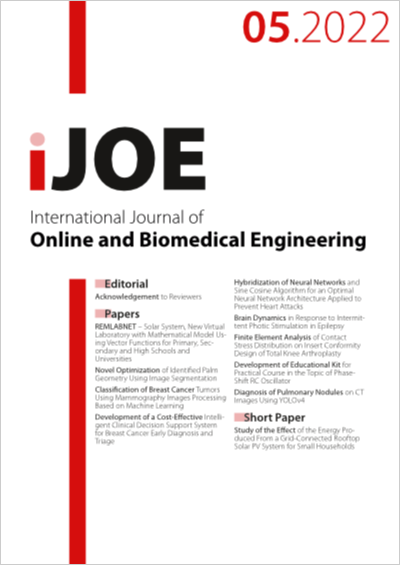Finite Element Analysis of Contact Stress Distribution on Insert Conformity Design of Total Knee Arthroplasty
DOI:
https://doi.org/10.3991/ijoe.v18i05.29355Keywords:
Insert conformity, Total Knee Arthroplasty, Contact stress, Finite Element AnalysisAbstract
The tibial insert conformity is one of the essential parameters concerned with the contact stress distribution of biomechanics characteristics in total knee arthroplasty (TKA). This study aimed to evaluate the effect of tibial insert conformity design on contact stress distribution using Finite Element (FE) analysis. The three-dimensional (3D) FE model of the posterior stabilized type of TKA was analyzed according to the standard knee implant loading. The 3k factorial experimental design was performed for the response surface of different insert curvatures consisting of the curve, partial flat, and flat insert conformity in sagittal and coronal planes. According to the result, the coronal and sagittal plane conformity displayed the effect of the change on the contact stress, including the contact area for the flexion angle of the knee joint. The maximum contact stress increased while the contact area value decreased during the flexion angle of the knee joints raised. The changing insert conformity value in the sagittal plane displayed higher sensitivity to contact stress than the changing conformity in the coronal plane. The relationship between the contact stress and tibial insert conformity under knee flexion angle indicates highly regression suitable for the prediction. In addition, the FE simulation result was then verified by compared to mechanical testing using the Fujifilm technique. The result of FE analysis exhibited similar to that of the mechanical test. The study indicated that the different geometric designs of the insert conformity played a crucial role that influenced and relationship to the contact stress of TKA
Downloads
Published
How to Cite
Issue
Section
License
Copyright (c) 2022 Techin Seechaipat, Supakit Rooppakhun, Chotchuang Phombut

This work is licensed under a Creative Commons Attribution 4.0 International License.



